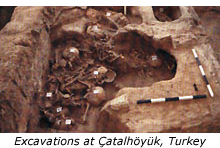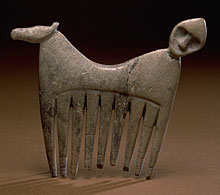|
|
|
 Historical analysis of material objects
requires careful description. Look around your home or classroom. Objects
are everywhere—jeans, coffee mugs, computers. You know what most of these
are because they are part of your familiar environment. A person who lived
a century ago, though, especially from a different part of the world, would
have a difficult time understanding your material culture. Imagine visiting
an archaeological excavation of a building erected 5,000 years ago in central
Turkey. How easy would it be to understand the building's purpose and the
function of the various objects, such as bone fragments and potsherds? Historical analysis of material objects
requires careful description. Look around your home or classroom. Objects
are everywhere—jeans, coffee mugs, computers. You know what most of these
are because they are part of your familiar environment. A person who lived
a century ago, though, especially from a different part of the world, would
have a difficult time understanding your material culture. Imagine visiting
an archaeological excavation of a building erected 5,000 years ago in central
Turkey. How easy would it be to understand the building's purpose and the
function of the various objects, such as bone fragments and potsherds?
To analyze material evidence is to write an object's biography.
Each object has a story to tell, a story shaped by human use. When historians
analyze material objects, they begin by recording basic “facts,” starting
with a verbal description and, if possible, photographs. The description might
include measurements, material, and distinguishing features, such as ornamentation.
This kind of information provides material for generalization about technology,
economy, or social relations within a given society and how they changed over
time. The material of the object (e.g., clay used to make a particular pot)
may make it possible to specify where it was produced, especially if we have
other evidence about centers of production.
When studying an object, start with these basic descriptions:
- Observe the object carefully, paying close attention to detail.
- Take notes on material, size, shape, and distinguishing
characteristics.
- Turn the object over if possible, examining from multiple angles and perspectives.
- Note what the descriptive label (from a book, website, or museum) tells you, but do not let that description limit your questions.
 These details are the first step to determining what an object is. But beware your assumptions! You are familiar with the fact that a comb has teeth, so you recognize a 5,000-year-old comb. What you may not know, however, is whether it had meaning beyond untangling hair, such as status for the wearer. A small, cylindrical piece of wood 2.5 cm. in height, slightly tapered from a base, with a diameter of 1.5 cm., might remind you of a chess piece. Such an object was found and so described in the ancient Russian city of Novgorod, but through extended study, archaeologists concluded that it was the blunt head of an arrow used to stun birds. All analysis begins with basic description. These details are the first step to determining what an object is. But beware your assumptions! You are familiar with the fact that a comb has teeth, so you recognize a 5,000-year-old comb. What you may not know, however, is whether it had meaning beyond untangling hair, such as status for the wearer. A small, cylindrical piece of wood 2.5 cm. in height, slightly tapered from a base, with a diameter of 1.5 cm., might remind you of a chess piece. Such an object was found and so described in the ancient Russian city of Novgorod, but through extended study, archaeologists concluded that it was the blunt head of an arrow used to stun birds. All analysis begins with basic description.
 
|




 Historical analysis of material objects
requires careful description. Look around your home or classroom. Objects
are everywhere—jeans, coffee mugs, computers. You know what most of these
are because they are part of your familiar environment. A person who lived
a century ago, though, especially from a different part of the world, would
have a difficult time understanding your material culture. Imagine visiting
an archaeological excavation of a building erected 5,000 years ago in central
Turkey. How easy would it be to understand the building's purpose and the
function of the various objects, such as bone fragments and potsherds?
Historical analysis of material objects
requires careful description. Look around your home or classroom. Objects
are everywhere—jeans, coffee mugs, computers. You know what most of these
are because they are part of your familiar environment. A person who lived
a century ago, though, especially from a different part of the world, would
have a difficult time understanding your material culture. Imagine visiting
an archaeological excavation of a building erected 5,000 years ago in central
Turkey. How easy would it be to understand the building's purpose and the
function of the various objects, such as bone fragments and potsherds? These details are the first step to determining what an object is. But beware your assumptions! You are familiar with the fact that a comb has teeth, so you recognize a 5,000-year-old comb. What you may not know, however, is whether it had meaning beyond untangling hair, such as status for the wearer. A small, cylindrical piece of wood 2.5 cm. in height, slightly tapered from a base, with a diameter of 1.5 cm., might remind you of a chess piece. Such an object was found and so described in the ancient Russian city of Novgorod, but through extended study, archaeologists concluded that it was the blunt head of an arrow used to stun birds. All analysis begins with basic description.
These details are the first step to determining what an object is. But beware your assumptions! You are familiar with the fact that a comb has teeth, so you recognize a 5,000-year-old comb. What you may not know, however, is whether it had meaning beyond untangling hair, such as status for the wearer. A small, cylindrical piece of wood 2.5 cm. in height, slightly tapered from a base, with a diameter of 1.5 cm., might remind you of a chess piece. Such an object was found and so described in the ancient Russian city of Novgorod, but through extended study, archaeologists concluded that it was the blunt head of an arrow used to stun birds. All analysis begins with basic description.